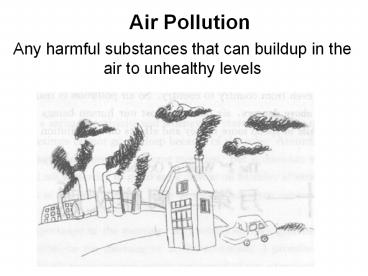Air Pollution - PowerPoint PPT Presentation
1 / 18
Title:
Air Pollution
Description:
Air Pollution Any harmful substances that can buildup in the air to unhealthy levels Sources of Pollution Primary Pollutant - Pollutant put directly into the air by ... – PowerPoint PPT presentation
Number of Views:59
Avg rating:3.0/5.0
Title: Air Pollution
1
Air Pollution
- Any harmful substances that can buildup in the
air to unhealthy levels
2
Sources of Pollution
Primary Pollutant - Pollutant put directly into
the air by human activity. -Ex soot from smoke.
Secondary Pollutant - Primary pollutant reacts
with other primary pollutants or with naturally
occurring substances. -Ex ground level ozone
(emissions react with oxygen)
3
Primary vs. Secondary Pollutants
4
Temperature Inversion
- Temp. Inversion when the air above is warmer
than the air below it. - A temperature inversion can trap pollutants near
the Earths surface b/c the warm air above
doesnt allow the cooler air to move upward. - Cities in a valley are more likely to experience
temp. inversions (Ex LA)
5
Air Pollution
- What is the most common source of primary air
pollutant in the US daily? - Which pollutant is released the most?
6
Types of Pollutants
- Carbon Monoxide - from car emissions
- Sulfur Dioxide from burning coal oil
7
Carbon Monoxide - Motor Vehicle Emissions
- Almost 1/3 of our air pollution comes from
gasoline burned by vehicles. - Regulation - The Clean Air Act (1970) gives EPA
the authority to regulate vehicle emissions in
the US. - Eliminated lead in gasoline (unleaded)
- Catalytic converters required that clean exhaust
gases before exiting the tailpipe
8
Sulfur Dioxide - Industrial Air Pollution
- Many industries, including power plants, burn
fuel to produce energy. - Burning fossil fuels releases, sulfur dioxide,
nitrogen oxides, carbon dioxide into the air. - Regulation - Clean Air Act requires many
industries to use scrubbers or other
pollution-control devices. - Scrubbers remove some of the more harmful
substances from emissions - Electrostatic precipitators remove dust particles
from smokestacks.
9
Environmental Effect Smog
- Air pollution that hangs over urban areas and
reduces visibility. - It results from chemical reactions that involve
sunlight, air, auto exhaust, and ozone. - Caused mainly by auto and industrial exhaust
10
Effects of Smog
- Effects on Humans
- Respiratory problems like - asthma
- emphysema
- chronic bronchitis - Eye irritations
- Reduced resistance to colds and lung infections.
- Effects on Plants
- Inhibits plant growth
- Damages crops
11
(No Transcript)
12
Environmental Effect Acid Precipitation -
precipitation that contains high concentrations
of acid.
- 1. Fossil fuels are burned,
- releasing sulfur
- nitrogen oxides
- 2. These oxides combine
- with water in the
- atmosphere, forming
- sulfuric acid nitric acid
- 3. Acid precipitation falls
- into lakes, rivers,
- streams killing
- organisms that live there
13
How Acidic Is It?
- pH is a measure of how acidic a substance is.
- The lower the pH number is, the more acidic a
substance is. - Pure water has a pH of 7.0 (neutral)
- Normal precipitation is slightly acidic (pH 5.6)
- Acid precipitation has a pH of less than 5.0
- pH of eastern US Canada ranges from 4.2-4.8
14
Effects of Acid Precipitation
- Effects on Soil
- Drop pH of soil
- Nutrients decrease
- Releases aluminum other toxic metals
- Effects on Plants
- Soil changes cause root damage
- Clogged openings on the surfaces of plants.
15
Effects of Acid Precipitation
- Effects on Aquatic Ecosystems
- Acid can kill fish other aquatic animals.
Aluminum builds up in the gills, suffocating
them.
- Effects on Humans
- Toxic metals can find their way into crops,
water, and fish - May increase respiratory problems
- Dissolves calcium carbonate in concrete, marble,
limestone, monuments (ancient pyramids, Lincoln
Memorial, etc.)
16
Problems with Acid Precipitation Control
- Pollutants are often released in an area far away
from the area where acid precipitation falls. - Ex acid rain in SE Canada is a result of
pollutants produced in NE United States.
17
Effects of Acid Precipitation Ex The
Adirondack Mountains
A tree is weakened over time by acid rain,
leaving it more susceptible to factors that would
otherwise be harmless. Spruce and fir trees are
so stressed by the acid pollution that they have
succumbed to severe cold, drought, insect
infestations or diseases. According to the U.S.
Forest Service, death rates for many tree species
have doubled or tripled in the last decade in the
Adirondack Mountains.
18
Where is the acid rain?
- Circle the areas with the most significant acid
rain. - Draw an arrow to the sources of the sulfur
dioxide.































